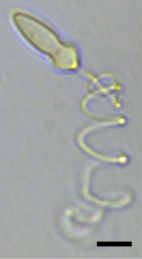
Photo from wikipedia
The harmful microalgae Gymnodinium catenatum is a unique naked dinoflagellate that produces paralytic shellfish poisoning toxins (PSTs). This species is common along the coasts of the Mexican Pacific and is… Click to show full abstract
The harmful microalgae Gymnodinium catenatum is a unique naked dinoflagellate that produces paralytic shellfish poisoning toxins (PSTs). This species is common along the coasts of the Mexican Pacific and is responsible for paralytic shellfish poisoning, which has resulted in notable financial losses in both fisheries and aquaculture. In the Gulf of California, G. catenatum has been related to mass mortality events in fish, shrimp, seabirds, and marine mammals. In this study, the growth, toxin profiles, and toxin content of four G. catenatum strains isolated from Bahía de La Paz (BAPAZ) and Bahía de Mazatlán (BAMAZ) were evaluated with different N:P ratios, keeping the phosphorus concentration constant. All strains were cultivated in semi-continuous cultures (200 mL, 21.0 °C, 120 µmol photon m−2s−1, and a 12:12 h light-dark cycle) with f/2 + Se medium using N:P ratios of: 4:1, 8:1, 16:1, 32:1, and 64:1. Paralytic toxins were analyzed by HPLC with fluorescence detection. Maximum cellular abundance and growth were obtained at an N:P ratio of 64:1 (3188 cells mL−1 and 0.34 div day−1) with the BAMAZ and BAPAZ strains. A total of ten saxitoxin analogs dominated by N-sulfocarbamoyl (60–90 mol%), decarbamoyl (10–20 mol%), and carbamoyl (5–10 mol%) toxins were detected. The different N:P ratios did not cause significant changes in the PST content or toxin profiles of the strains from both bays, although they did affect cell abundance.
Journal Title: Toxins
Year Published: 2022
Link to full text (if available)
Share on Social Media: Sign Up to like & get
recommendations!